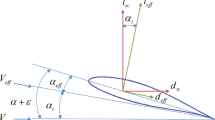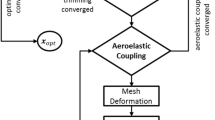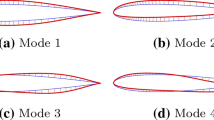Abstract
Natural laminar flow is one of the most promising ways to reduce the drag of future aircraft configurations. However, there is a lack of efficient tools for performing shape optimization considering laminar-to-turbulent transition. This is in part because including crossflow instabilities in the optimization is challenging. This paper addresses this need by developing a discrete, adjoint-based optimization framework where transition is modeled considering both Tollmien and Schlichting waves and crossflow instabilities. The framework is based on a Reynolds-averaged Navier–Stokes computational fluid dynamics solver coupled with a transition simulation module externally by incorporating into the Spalart–Allmaras turbulence model through a smooth intermittency function. The transition simulation module consists of a laminar boundary-layer equations solver and a simplified stability analysis method based on the Drela–Giles method and the C1 criterion. A Jacobian-free coupled-adjoint method is used to compute the gradients of the transition prediction. Lift-constrained drag minimization of a transonic infinite span wing with 25∘ of sweep is performed. The optimizer successfully reduces the drag coefficient by 43.34%, owing to an extended laminar region on the wing surface, and finds a pressure distribution that strikes a balance between the Tollmien–Schlichting wave and crossflow instability transition mechanisms.















Similar content being viewed by others
References
Agarwal R K (2011) Environmentally responsible air and ground transportation. In: 49th AIAA Aerospace Sciences Meeting Including the New Horizons Forum and Aerospace Exposition. https://doi.org/10.2514/6.2011-965
Albring T, Sagebaum M, Gauger N R (2016) New results in numerical and experimental fluid mechanics X: Contributions to the 19th STAB/DGLR Symposium Munich, Germany, 2014. In: Dillmann A, Heller G, Krämer E, Wagner C, Breitsamter C (eds). https://doi.org/10.1007/978-3-319-27279-5_7. Springer International Publishing, Cham, pp 77–86
Amoignon O G, Pralits J O, Hanifi A, Berggren M, Henningson D S (2006) Shape optimization for delay of laminar-turbulent transition. AIAA J 44(5):1009–1024. https://doi.org/10.2514/1.12431
Arnal D (1988) Transition prediction in transonic flow. In: IUTAM Symposium Transsonicum III DFVLR-AVA, pp 253–262. https://doi.org/10.2514/6.1998-2824
Arnal D, Houdeville R, Seraudie A, Vermeersch O (2012) Overview of laminar-turbulent transition investigations at ONERA Toulouse. In: 41st AIAA Fluid Dynamics Conference and Exhibit, Honolulu. https://doi.org/10.2514/6.2011-3074
Arnal D, Casalis G (2000) Laminar-turbulent transition prediction in three-dimensional flows. Prog Aerosp Sci 36(2):173–191. https://doi.org/10.1016/S0376-0421(00)00002-6
Bons N P, Mader C A, Martins J R R A, Cuco A P C, Odaguil F I K (2018) High-fidelity aerodynamic shape optimization of a full configuration regional jet. In: 2018 AIAA/ASCE/AHS/ASC Structures, Structural Dynamics, and Materials Conference, Kissimmee. https://doi.org/10.2514/6.2018-0106
Brezillon J, Dwight R P (2012) Applications of a discrete viscous adjoint method for aerodynamic shape optimisation of 3D configurations. CEAS Aeronaut J 3(1):25–34. https://doi.org/10.1007/s13272-011-0038-0
Cebeci T, Kaups K, Ramsey J A (1977) A general method for calculating three-dimensional compressible laminar and turbulent boundary layers on arbitrary wings. NASA CR-2777
Cebeci T (2004) Stability and transitivon: theory and application. Efficient numerical methods with computer programs. Springer, Berlin
Cella U, Quagliarella D, Donelli R, Imperatore B (2010) Design and test of the UW-5006 transonic natural-laminar-flow wing. J Aircr 47(3):783–795. https://doi.org/10.2514/1.40932
Choi J H, Kwon O J (2015) Enhancement of a correlation-based transition turbulence model for simulating crossflow instability. AIAA J 53(10):3063–3072. https://doi.org/10.2514/1.J053887
Cliquet J, Houdeville R, Arnal D (2008) Application of laminar-turbulent transition criteria in Navier–Stokes computations. AIAA J 46(5):1182–1190. https://doi.org/10.2514/1.30215
Coder J G, Maughmer M D (2014) Computational fluid dynamics compatible transition modeling using an amplification factor transport equation. AIAA J 52(11):2506–2512
Coder J G, Pulliam T H, Hue D, Kenway G K W, Sclafani A J (January 2017) Contributions to the 6th AIAA CFD Drag Prediction Workshop using structured grid methods. In: AIAA SciTech Forum. American Institute of Aeronautics and Astronautics. https://doi.org/10.2514/6.2017-0960
Coder J G (2019) Further development of the amplification factor transport transition model for aerodynamic flows. In: Proceedings of the AIAA Scitech 2019 Forum, San Diego. https://doi.org/10.2514/6.2019-0039
Dagenhart JR, Saric W S (1999) Crossflow stability and transition experiments in swept-wing flow. Technical report, NASA Langley Research Center, Hampton. NASA-TP-1999-209344
Dhawan SJ, Narasimha R (1958) Some properties of boundary layer flow during the transition from laminar to turbulent motion. J Fluid Mech 3(4):418–436. https://doi.org/10.1017/S0022112058000094
Drela M, Giles M B (1987) Viscous-inviscid analysis of transonic and low Reynolds number airfoils. J Aircr 25(10):1347–1355
Drela M (1989) XFOIL — an analysis and design system for low Reynolds number airfoils. In: Low Reynolds number aerodynamics. Notre Dame
Drela M (1993) Design and optimization method for multi-element airfoils aerospace design conference. In: Proceedings of the AIAA/AHS/ASEE Aerospace Design Conference, Irvine. https://doi.org/10.2514/6.1993-969,
Driver J, Zingg D W (2007) Numerical aerodynamic optimization incorporating laminar-turbulent transition prediction. AIAA J 45(8):1810–1818. https://doi.org/10.2514/1.23569
Fu S, Wang L (2013) RANS modeling of high-speed aerodynamic flow transition with consideration of stability theory. Prog Aerosp Sci 58:36–59. https://doi.org/10.1016/j.paerosci.2012.08.004
Gill P E, Murray W, Saunders M A (2005) SNOPT: an SQP algorithm for large-scale constrained optimization. SIAM Rev 47(1):99–131. https://doi.org/10.1137/S0036144504446096
Grabe C, Shengyang N, Krumbein A (2018) Transport modeling for the prediction of crossflow transition. AIAA J 56(8):3167–3178. https://doi.org/10.2514/1.j056200
Hascoët L, Pascual V (2004) TAPENADE 2.1 user’s guide. Technical report 300, INRIA
He P, Mader C A, Martins J R R A, Maki K J (2018) An aerodynamic design optimization framework using a discrete adjoint approach with OpenFOAM. Comput Fluids 168:285–303. https://doi.org/10.1016/j.compfluid.2018.04.012
Horstmann KH (2006) Telfona, contribution to laminar wing development for future transport aircraft. Aeronautical Days, Vienna
Horton H P, Stock H-W (1995) Computation of compressible, laminar boundary layers on swept, tapered wings. J Aircr 32(6):1402–1405
Irons B M, Tuck R C (1969) A version of the Aitken accelerator for computer iteration. Int J Numer Methods Eng 1(3):275–277. https://doi.org/10.1002/nme.1620010306
Jameson A (September 1988) Aerodynamic design via control theory. J Sci Comput 3(3):233–260. https://doi.org/10.1007/BF01061285
Kaups K, Cebeci T (1977) Compressible laminar boundary layers with suction on swept and tapered wings. J Aircr 14(7):661–667
Kenway G K W, Secco N, Martins J R R A, Mishra A, Duraisamy K (2017) An efficient parallel overset method for aerodynamic shape optimization. In: Proceedings of the 58th AIAA/ASCE/AHS/ASC Structures, Structural Dynamics, and Materials Conference, AIAA SciTech Forum, Grapevine. https://doi.org/10.2514/6.2017-0357
Kenway G K W, Mader C A, He P, Martins J R R A (2019a) CFD discrete adjoint benchmarks. Mendeley Data. https://doi.org/10.17632/w4hsj8wzm8
Kenway G K W, Mader C A, He P, Martins J R R A (2019b) Effective adjoint approaches for computational fluid dynamics. Prog Aerosp Sci 110:100542. https://doi.org/10.1016/j.paerosci.2019.05.002
Khayatzadeh P, Nadarajah S (2012) Aerodynamic shape optimization of natural laminar flow (NLF) airfoils. In: 50th AIAA Aerospace Sciences Meeting including the New Horizons Forum and Aerospace Exposition, pp 1–15. https://doi.org/10.2514/6.2012-61
Krishnan K SG, Bertram O, Seibel O (2017) Review of hybrid laminar flow control systems. Prog Aerosp Sci 93:24–52. https://doi.org/10.1016/j.paerosci.2017.05.005
Krumbein A, Krimmelbein N, Schrauf G (2009a) Automatic transition prediction in hybrid flow solver, part 1: methodology and sensitivities. J Aircr 46(4):1176–1190. https://doi.org/10.2514/1.39736
Krumbein A, Krimmelbein N, Schrauf G (2009b) Automatic transition prediction in hybrid flow solver, part 2: practical application. J Aircr 46(4):1191–1199. https://doi.org/10.2514/1.39738
Krumbein A, Krimmelbein N, Schrauf G (2010) Automatic transition prediction for three-dimensional aircraft configurations using the dlr tau code. In: New results in numerical and experimental fluid mechanics VII. Springer, pp 101–108
Lambe A B, Martins J R R A (2012) Extensions to the design structure matrix for the description of multidisciplinary design, analysis, and optimization processes. Struct Multidiscip Optim 46:273– 284. https://doi.org/10.1007/s00158-012-0763-y
Langtry R B, Menter F R (2009) Correlation-based transition modeling for unstructured parallelized computational fluid dynamics codes. AIAA J 47(12):2894–2906. https://doi.org/10.2514/1.42362
Lawson S, Ciarella A, Wong P W (2018) Development of experimental techniques for hybrid laminar flow control in the ARA transonic wind tunnel. In: 2018 Applied Aerodynamics Conference, pp 3181. https://doi.org/10.2514/6.2018-3181
Lee J-D, Jameson A (2009a) NLF wing design by adjoint method and automatic transition prediction. Ph.D. Thesis, Stanford
Lee J-D, Jameson A (2009b) Natural-laminar-flow airfoil and wing design by adjoint method and automatic transition prediction. In: 47th AIAA Aerospace Sciences Meeting including The New Horizons Forum and Aerospace Exposition. https://doi.org/10.2514/6.2009-897
Li J, Zhang M, Martins J R R A, Shu C (2020) Efficient aerodynamic shape optimization with deep-learning-based filtering. AIAA J 58(10):4243–4259. https://doi.org/10.2514/1.J059254
Liao W, Malik M R, Lee-Rausch E M, Li F, Nielsen E J, Buning P G, Choudhari M, Chang C-L (2015) Boundary-layer stability analysis of the mean flows obtained using unstructured grids. J Aircr 52(1):49–63. https://doi.org/10.2514/1.C032583
Lyu Z, Kenway G K W, Martins J R R A (2015a) Aerodynamic shape optimization investigations of the Common Research Model wing benchmark. AIAA J 53(4):968–985. https://doi.org/10.2514/1.J053318
Lyu Z, Martins J R R A (2015b) Aerodynamic shape optimization of an adaptive morphing trailing edge wing. J Aircr 52(6):1951–1970. https://doi.org/10.2514/1.C033116
Mader C A, Martins J R R A, Alonso J J, van der Weide E (2008) ADjoint: An approach for the rapid development of discrete adjoint solvers. AIAA J 46(4):863–873
Mader C A, Kenway G K W, Yildirim A, Martins J R R A (2020) ADflow: an open-source computational fluid dynamics solver for aerodynamic and multidisciplinary optimization. Journal of Aerospace Information Systems. https://doi.org/10.2514/1.I010796
Martins J R R A, Sturdza P, Alonso J J (2003) The complex-step derivative approximation. ACM Trans Math Softw 29(3):245–262. https://doi.org/10.1145/838250.838251
Mavriplis D J (2007) Discrete adjoint-based approach for optimization problems on three-dimensional unstructured meshes. AIAA J 45(4):741–750. https://doi.org/10.2514/1.22743
Mayle R E (1991) The role of laminar-turbulent transition in gas turbine engines. J Turbomach 113(4):1–28. https://doi.org/10.1115/1.2929110
Michel R, Arnal D, Coustols E (1985) Stability calculations and transition criteria on two-or three-dimensional flows. In: Laminar-turbulent transition. Springer, pp 455–461
Moens F, Perraud J, Krumbein A, Toulorge T, Ianelli P, Eliasson P, Hanifi A (2008) Transition prediction and impact on a three-dimensional high-lift-wing configuration. J Aircr 45(5):1751–1766. https://doi.org/10.2514/1.36238
Müller J-D, Mykhaskiv O, Hückelheim J (2018) STAMPS: a finite-volume solver framework for adjoint codes derived with source-transformation AD. In: AIAA Multidisciplinary Analysis and Optimization Conference. https://doi.org/10.2514/6.2018-2928
Perraud J, Arnal D, Casalis G, Archambaud J-P, Donelli R (2009) Automatic transition predictions using simplified methods. AIAA J 47(11):2676–2684. https://doi.org/10.2514/1.42990
Rashad R (2016a) High-fidelity aerodynamic design optimization for natural laminar flow. Ph.D. Thesis, Toronto
Rashad R, Zingg D W (2016b) Aerodynamic shape optimization for natural laminar flow using a discrete-adjoint approach. AIAA J 54(11):3321–3337. https://doi.org/10.2514/1.J054940
Risse K (2016) Preliminary overall aircraft design with hybrid laminar flow control: Vorentwurf von flugzeugen mit hybrider laminarer strömungskontrolle. rwth aachen university, Ph.D. Thesis, Aachen
Saric W S, Reed H L, White E B (2003) Stability and transition of three-dimensional boundary layers. Ann Rev Fluid Mech 35(1):413–440. https://doi.org/10.1146/annurev.fluid.35.101101.161045
Secco N R, Jasa J P, Kenway G K W, Martins J R R A (2018) Component-based geometry manipulation for aerodynamic shape optimization with overset meshes. AIAA J 56(9):3667–3679. https://doi.org/10.2514/1.J056550
Shi Y, Gross R, Mader C A, Martins J R R A (2018) Transition prediction based on linear stability theory with the RANS solver for three-dimensional configurations. In: Proceedings of the AIAA Aerospace Sciences Meeting. AIAA SciTech Forum, Kissimmee. https://doi.org/10.2514/6.2018-0819
Shi R, Liu L, Long T, Wu Y, Tang Y (2019a) Filter-based adaptive Kriging method for black-box optimization problems with expensive objective and constraints. Comput Methods Appl Mech Eng 347:782–805. https://doi.org/10.1016/j.cma.2018.12.026
Shi Y, Cao T, Yang T, Bai J, Qu F, Yang Y (2019b) The estimation and analysis of an algorithm for hybrid laminar flow control based on a transonic experiment. AIAA J 58(1):118–. https://doi.org/10.2514/1.J058266
Shi Y, Mader C A, He S, Halila G L O, Martins J R R A (2020) Natural laminar-flow airfoil optimization design using a discrete adjoint approach. AIAA J 58(11):4702–4722. https://doi.org/10.2514/1.J058944
Spalart P, Allmaras S (1992) A one-equation turbulence model for aerodynamic flows. In: 30th Aerospace Sciences Meeting and Exhibit. https://doi.org/10.2514/6.1992-439
Streit T, Horstmann K, Schrauf G, Hein S, Fey U, Egami Y, Perraud J, El Din I S, Cella U, Quest J (2011) Complementary numerical and experimental data analysis of the ETW Telfona Pathfinder wing transition tests. In: 49th AIAA Aerospace Sciences Meeting including the New Horizons Forum and Aerospace Exposition, pp 1–16. https://doi.org/10.2514/6.2011-881
Streit T, Wedler S, Kruse M (2015) DLR natural and hybrid transonic laminar wing design incorporating new methodologies. Aeronaut J 119(1221):1303–1326. https://doi.org/10.1017/S0001924000011283
Yildirim A, Kenway G K W, Mader C A, Martins J R R A (November 2019) A Jacobian-free approximate Newton–Krylov startup strategy for RANS simulations. J Comput Phys 397:108741. https://doi.org/10.1016/j.jcp.2019.06.018
Zhang P, Lu J, Wang Z, Song L, Feng Z (2015) Adjoint-based optimization method with linearized SST turbulence model and a frozen gamma-theta transition model approach for turbomachinery design. In: ASME Turbo Expo 2015: Turbine Technical Conference and Exposition. American Society of Mechanical Engineers, pp 19–34. https://doi.org/10.1115/GT2015-42582
Author information
Authors and Affiliations
Corresponding author
Ethics declarations
Conflict of interest
The authors declare that they have no conflict of interest.
Additional information
Responsible Editor: Gregoire Allaire
Replication of results
The numerical results preseted to support the conlusiosn outlined can be obtained using existing approaches described in the literature. To replicate the resulte of Fig. 4, Fig.5, Fig.12, Fig.13, the linear stability theory with method (Cebeci 1977, Drela 1987, Grabe 2018) should to be used. In the Fig.5, the geometry and experimental details are described in Yayun 2020. To replicate the results of the gradient-based verification and optimization results (Fig.6, Fig.7, Fig.8, Fig.9, Fig.10, Fig.11), the derivarives of analytical expressions are described in Kenway 2019 and the corresponding open access code can be found by Mader 2020.
Publisher’s note
Springer Nature remains neutral with regard to jurisdictional claims in published maps and institutional affiliations.
Rights and permissions
About this article
Cite this article
Shi, Y., Mader, C.A. & Martins, J.R.R.A. Natural laminar flow wing optimization using a discrete adjoint approach. Struct Multidisc Optim 64, 541–562 (2021). https://doi.org/10.1007/s00158-021-02936-w
Received:
Revised:
Accepted:
Published:
Issue Date:
DOI: https://doi.org/10.1007/s00158-021-02936-w




